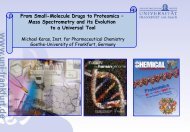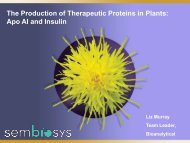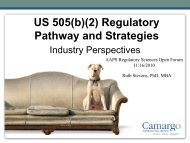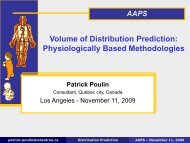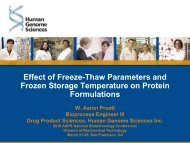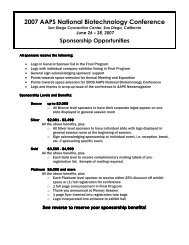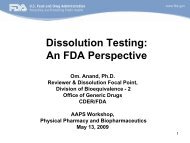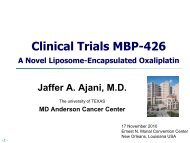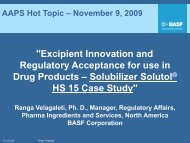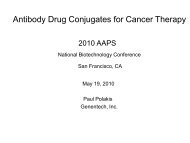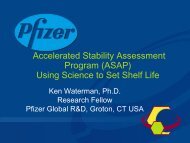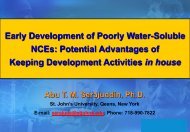Protein Aggregation and Immunogenicity
Protein Aggregation and Immunogenicity
Protein Aggregation and Immunogenicity
You also want an ePaper? Increase the reach of your titles
YUMPU automatically turns print PDFs into web optimized ePapers that Google loves.
<strong>Protein</strong> <strong>Aggregation</strong> <strong>and</strong> <strong>Immunogenicity</strong><br />
Critical Role of the Formulation<br />
Wim Jiskoot<br />
Division of Drug Delivery Technology<br />
Leiden/Amsterdam Center for Drug Research (LACDR)<br />
PSWC-AAPS<br />
New Orleans<br />
17 November 2010
Practically all proteins are immunogenic<br />
• <strong>Protein</strong>s of animal origin (> 1920s)<br />
e.g. porcine/bovine insulin<br />
• Human derived proteins (> 1950s)<br />
growth hormone, factor VIII<br />
• Recombinant human proteins (> 1980s)<br />
insulin, interferons, GM-CSF, epo<br />
• Monoclonal antibodies (> 1980s)<br />
mouse, chimeric, humanized, human<br />
• Follow-on biologics / biosimilars (> 2000s)<br />
growth hormone, epoetin, filgrastim ...<br />
Impurities,<br />
contaminants<br />
Product quality
<strong>Immunogenicity</strong> - definition<br />
T cell<br />
activation<br />
Innate immunity<br />
CDC<br />
(complement<br />
dependent<br />
cytotoxicity)<br />
Cell mediated<br />
cytotoxicity<br />
The ability of a<br />
substance (e.g. antigen<br />
or vaccine) to elicit an<br />
immune response<br />
Hypersensitivity<br />
ADCC<br />
(antibody-dependent cellmediated<br />
cytotoxicity )<br />
Cytokine<br />
storm<br />
Anti-drug antibodies
<strong>Immunogenicity</strong> - definition<br />
T cell<br />
activation<br />
Innate immunity<br />
CDC<br />
(complement<br />
dependent<br />
cytotoxicity)<br />
Cell mediated<br />
cytotoxicity<br />
The ability of a<br />
substance (e.g. antigen<br />
or vaccine) to elicit an<br />
immune response<br />
Hypersensitivity<br />
ADCC<br />
(antibody-dependent cellmediated<br />
cytotoxicity )<br />
Anti-Drug Antibodies<br />
Cytokine<br />
storm<br />
Anti-drug antibodies
Clinical consequences of immunogenicity vary <strong>and</strong> are<br />
highly unpredictable<br />
Loss of therapeutic efficacy (common)<br />
IFN-beta, IFN-alfa, anti-TNF proteins, insulin, monoclonals…<br />
Increase of therapeutic efficacy (rare)<br />
growth hormone<br />
Neutralization of endogenous protein (rare)<br />
epoetin, MDGF<br />
General immune effects<br />
allergy, anaphylaxis, serum sickness, etc.<br />
None (common)
Formation of anti-drug antibodies in patient receiving<br />
an anti-TNFα MAb<br />
MAb conc. (ng/ml)<br />
10000<br />
1000<br />
100<br />
30<br />
20<br />
10<br />
Anti-MAb (% binding)<br />
10<br />
0<br />
0 10 20 30 40 50 60<br />
Week<br />
Courtesy of Lucien Aarden
Factors influencing immunogenicity of proteins
Factors influencing immunogenicity of proteins<br />
So, THE immunogenicity of a protein does not exist<br />
Product Characteristics Indication <strong>Immunogenicity</strong> (%)<br />
Rituxan/rituximab chimeric/ CD20 NHL 0<br />
Rituxan/rituximab chimeric / CD20 SLE 65<br />
Rituxan/rituximab chimeric / CD20 PSS 27
Factors influencing immunogenicity<br />
Product Quality<br />
&<br />
Formulation
Simplified summary:<br />
protein aggregates are immunogenic
Aggregates <strong>and</strong> immunogenicity: clinical evidence<br />
• Intravenous immunoglobulins (1950s, 1960s)<br />
– Aggregate removal resulted in less immunogenic products<br />
• Human growth hormone purified from formalin-fixed<br />
pituitary gl<strong>and</strong>s (1950s)<br />
– The higher the aggregate levels (up to 70%!) the more<br />
immunogenic<br />
• Betaseron<br />
– Contains substantial aggregate levels <strong>and</strong> is more immunogenic<br />
than other interferon-beta products<br />
• Interleukin 2<br />
– Aggregated formulation induced antibodies in most patients<br />
• Interferon-alfa<br />
– Formulation with oxidized <strong>and</strong> aggregated products was more<br />
immunogenic than other formulations<br />
Hermeling et al., Pharm Res, 2004; Rosenberg, AAPS J, 2006
Antibody response to human growth hormone: aggregate<br />
level determines antibody response <strong>and</strong> persistence<br />
(Moore <strong>and</strong> Leppert 1980)<br />
% 125 I-hGH Bound<br />
50<br />
40<br />
30<br />
Highly aggregated HGH<br />
Minimally aggregated HGH<br />
0.28<br />
0.24<br />
0.20<br />
0.16<br />
0.12<br />
0.08<br />
0.04<br />
0<br />
40<br />
60<br />
Monomer<br />
80<br />
100<br />
20<br />
10<br />
0.28<br />
0.24<br />
0.20<br />
0.16<br />
0.12<br />
0.08<br />
0.04<br />
Monomer<br />
0<br />
3<br />
6 9 12<br />
Months of therapy<br />
15<br />
28<br />
0<br />
40<br />
60 80 100<br />
Courtesy of Amy Rosenberg
<strong>Immunogenicity</strong>: the formulation matters<br />
Neutralizing antibodies<br />
<strong>Immunogenicity</strong> differences between IFN-a2 formulations<br />
2000<br />
1800<br />
1600<br />
1400<br />
1200<br />
1000<br />
800<br />
600<br />
400<br />
200<br />
0<br />
0 1 2 3 4 5 6 7 8<br />
Duration of treatment (months)<br />
B (n = 86)<br />
C (n = 110)<br />
D (n = 81)<br />
E (n = 74)<br />
A (n = 190)<br />
Ryff, J Interferon Cytokine Res, 1997
<strong>Immunogenicity</strong>: the formulation matters<br />
Reformulated REBIF (interferon beta) shows reduced<br />
immunogenicity in phase IIIb clinical trial<br />
260 patients - persistent neutralizing antibodies:<br />
Old = 14%, high titers, 58% relapse free<br />
RNF2 = 2.5%, low titers, 67% relapse free<br />
Courtesy of Matthew Baker
<strong>Immunogenicity</strong>: the formulation matters<br />
Number of Epoetin Alfa<br />
PRCA Cases<br />
Anti-epoetin antibody-related pure red cell aplasia<br />
Formulation change<br />
Replacement of albumin by Tween 80/glycine in epoetin alfa (outside USA)<br />
80<br />
70<br />
60<br />
50<br />
40<br />
30<br />
20<br />
10<br />
0<br />
Why are recombinant human proteins immunogenic<br />
Simpliflied scheme of the immune system<br />
<br />
M. Salmon, 1994<br />
Courtesy of Matthew Baker
Fate of auto-reactive B cells after encountering<br />
self-protein arrays on virus like particles (VLPs)<br />
Monomeric B-cell receptor /<br />
self-Ag complexes<br />
Oligomerization of B-cell receptor /<br />
self-Ag signaling complexes<br />
Toleragenic Signals<br />
Proliferative Signals
Any substance can be rendered immunogenic!<br />
Soluble molecules:<br />
B-cell tolerance<br />
Repetitive epitopes on polymeric or<br />
particulate drug carriers: B-cell stimulation<br />
Prerequisites:<br />
• At least 10-20 repetitive epitopes ()<br />
• Inter-epitope distance between 5-10 nm<br />
Jiskoot et al., Pharm Res 26: 1303-1314 (2009)
B-cell stimulation by epitope arrays<br />
Wouldn’t protein aggregates act similarly <br />
= protein molecule<br />
And particles with adsorbed proteins<br />
= protein molecule<br />
Poliovirus<br />
FMD Virus
<strong>Protein</strong> immunogenicity – our current knowledge<br />
• Practically all rh therapeutic proteins <strong>and</strong> antibodies are<br />
immunogenic<br />
• We do not exactly know why<br />
• Besides patient- <strong>and</strong> treatment-related factors,<br />
formulation <strong>and</strong> product quality are important<br />
• Aggregates are suspicious as risk factors<br />
• We do not know which aggregates<br />
• We do not know the critical aggregate dose
<strong>Protein</strong> immunogenicity – our current knowledge<br />
Product quality<br />
Formulation <strong>and</strong><br />
characterization tools,<br />
PAT, QbD, …<br />
Clinical immunogenicity<br />
<strong>Immunogenicity</strong> assays<br />
THE GAP:<br />
Predictive models to link the two;<br />
underst<strong>and</strong>ing immune mechanisms
Tools to predict immunogenicity<br />
• Process / formulation characterization<br />
(including aggregates, particles…)<br />
• Animal studies - transgenics<br />
• In silico B-cell prediction<br />
• In silico T-cell prediction<br />
• T-cell epitope screening assays<br />
uncapable of<br />
predicting<br />
formulationrelated<br />
factors<br />
• T-cell activation assays<br />
• Clinical studies<br />
• Postmarketing surveillance / pharmacovigilance
Tools to predict immunogenicity<br />
• Process / formulation characterization<br />
(including aggregates, particles…)<br />
• Animal studies - transgenics<br />
• In silico B-cell prediction<br />
• In silico T-cell prediction<br />
• T-cell epitope screening assays<br />
• T-cell activation assays<br />
THE MAIN CHALLENGE NOW:<br />
• Clinical How studies to bridge the gap<br />
• Postmarketing surveillance / pharmacovigilance
Tools to predict immunogenicity<br />
Transgenic immune tolerant mouse<br />
models to correlate<br />
Product Quality & Formulation<br />
to<br />
<strong>Immunogenicity</strong>
Human interferon-a2 immune tolerant mice<br />
IgG Titer<br />
100000<br />
rhIFN a2b<br />
ovalbumin<br />
10000<br />
1000<br />
Titers on<br />
day 22<br />
100<br />
10<br />
Wildtypes<br />
Transgenics<br />
Week 1 Week 2 Week 3<br />
Day 1 Day 8<br />
Day 15<br />
Day 22<br />
5 μg / injection<br />
Blood sampling<br />
(s.c. or i.p.)
Preparation of aggregated rhIFNa2<br />
optical density<br />
Fluorescence intensity<br />
OD 214 nm<br />
SDS-PAGE (non-reducing)<br />
HPLC-SEC<br />
0.20 Native<br />
Hydrogenperoxide<br />
0.15<br />
Metal-catalyzed<br />
Glutaraldehyde<br />
0.10<br />
Boiled<br />
0.05<br />
0.00<br />
10 20 30 40<br />
Time (min)<br />
0.30<br />
0.25<br />
0.20<br />
0.15<br />
0.10<br />
0.05<br />
UV/Vis spectroscopy<br />
Native<br />
Hydrogen peroxide<br />
Metal-catalyzed<br />
Glutaraldehyde<br />
Boiled<br />
Trp fluorescence spectroscopy<br />
3.0×10 7 Native<br />
Hydrogenperoxide<br />
2.0×10 7<br />
Metal-catalyzed<br />
Glutaraldehyde<br />
1.0×10 7<br />
Boiled<br />
0.00<br />
200 250 300 350 400 450<br />
Wavelength (nm)<br />
0<br />
300 325 350 375 400 425 450<br />
Emission wavelength (nm)<br />
Hermeling et al., Pharm Res 22, 1997-2006 (2005)
Only “native like” aggregates induce antibodies against native<br />
recombinant human IFNa2a in transgenic mice<br />
anti-rhIFNa2b IgG titer<br />
1000<br />
t=14 days t=21 days<br />
100<br />
10<br />
5/5<br />
4/5<br />
N M G H B<br />
N= untreated<br />
M= metal-catalyzed oxidized<br />
G= glutaraldehyde treated<br />
H= oxidized by H 2 O 2<br />
B= boiled<br />
Hermeling et al., Pharm Res 22, 1997-2006 (2005)
<strong>Immunogenicity</strong> of “native like” aggregates of recombinant<br />
human IFNa2a in transgenic mice is dose dependent<br />
IgG titer<br />
b<br />
Wildtype<br />
Transgenic<br />
10000<br />
1000<br />
**<br />
***<br />
***<br />
5/5<br />
4/5<br />
5/5<br />
100<br />
2/5<br />
10<br />
ND<br />
A B C D E<br />
Increasing aggregate content<br />
Hermeling et al., J Pharm Sci 95, 1084-1096 (2006)
Memory study - injection <strong>and</strong> blood sampling scheme<br />
Week 1 Week 2 Week 3<br />
t = 0 t = 7 t = 14 t = 21 days<br />
… Week 9<br />
Week 4<br />
Wash out<br />
Week 10 Week 11<br />
Boost<br />
Blood sampling<br />
Injection (i.p.) with<br />
5 μg protein
Transgenic immune tolerant mice do not show immunological<br />
memory against aggregated rh IFNa2a<br />
Anti-rhIFNa2a antibody titers before <strong>and</strong> after a<br />
6-week wash-out period<br />
Sauerborn et al. (2010) Manuscript in preparation
Antibody response against aggregated rhIFNa2a is T cell<br />
dependent – in both wildtype <strong>and</strong> transgenic mice<br />
Anti-rhIFNa2a antibody titers after a 3-week<br />
injection protocol<br />
– CD4 + T cells<br />
depleted<br />
+ undepleted<br />
Sauerborn et al. (2010) Manuscript in preparation
Antibody response against aggregated rhIFNa2a is T cell<br />
dependent – in both wildtype <strong>and</strong> transgenic mice<br />
Anti-rhIFNa2a antibody titers after a 3-week<br />
injection protocol<br />
Pneumovax<br />
(TI antigen)<br />
– CD4 + T cells<br />
blocked<br />
+ not blocked<br />
Sauerborn et al. (2010) Manuscript in preparation
Aggregated rhIFNb does not act as an adjuvant for native<br />
rhIFNa2a in transgenic mice<br />
Anti-rhIFNa2a antibody titers after a 3-week<br />
injection protocol<br />
rhIFNb<br />
Sauerborn et al. (2010) Manuscript in preparation
IgG titer<br />
IgG titer<br />
Adsorption of rhIFNb to metal (but not glass or polystyrene)<br />
beads enhances its immunogenicity in transgenic mice<br />
Anti-rhIFNb antibody titers after a 3-week injection<br />
protocol<br />
10000<br />
10000<br />
p
Conclusions from studies with transgenic mice<br />
Transgenic immune tolerant mice are useful models to<br />
study product-related factors of immunogenicity:<br />
• Some aggregates were shown to be immunogenic, others not<br />
• <strong>Immunogenicity</strong> of aggregates is dose dependent<br />
• <strong>Protein</strong> adsorption to non-proteinaceous subvisible particles can<br />
promote antibody formation<br />
• Immune mechanism differs from a classical vaccination reaction:<br />
- No memory<br />
- CD4 + T-cell dependent
Proposed mechanisms of antibody induction by<br />
protein aggregates<br />
V. Filipe et al. In: <strong>Aggregation</strong> of Therapeutic <strong>Protein</strong>s (W. Wang <strong>and</strong> C.J. Roberts, Eds.),<br />
John Wiley & Sons, Hoboken, NJ, pp. 403-433 (2010)
<strong>Protein</strong> immunogenicity – wrap up<br />
Still work to do!
Acknowledgments<br />
The immunogenicity team<br />
Mir<strong>and</strong>a van Beers<br />
Melody Sauerborn<br />
Suzanne Hermeling<br />
Vasco Filipe<br />
Riccardo Torosantucci<br />
Andrea Hawe<br />
Ruediporn (Sun) Tantipolphan<br />
Vera Brinks<br />
Basak Kukrer<br />
UIPS<br />
Utrecht Institute for<br />
Pharmaceutical Sciences<br />
Ted R<strong>and</strong>olph<br />
Jared Bee<br />
Daan Crommelin<br />
Huub Schellekens<br />
And may others – students, technicians, collaborators…
Thank you !<br />
Hope to see you again at the<br />
Third Open Scientific EIP Symposium<br />
<strong>Immunogenicity</strong> of Biopharmaceuticals<br />
8-9 December 2010, Gent, Belgium<br />
Info & registration: http://e-i-p.eu
Epitope presentation in protein aggregates<br />
Native<br />
protein molecules<br />
V. Filipe et al. In: <strong>Aggregation</strong> of Therapeutic <strong>Protein</strong>s (W. Wang <strong>and</strong> C.J. Roberts, Eds.),<br />
John Wiley & Sons, Hoboken, NJ, pp. 403-433 (2010)
IgG titer<br />
Transgenic immune tolerant mice do not show immunological<br />
memory against aggregated rhIFNb<br />
Anti-rhIFNb antibody titers before <strong>and</strong> after a 6-week<br />
wash-out period<br />
100000<br />
10000<br />
1000<br />
100<br />
10<br />
Before After Before After<br />
Wildtype<br />
Transgenic<br />
Cf clinical data: Perini et al., (2001)<br />
Millonig et al. (2009)<br />
Van Beers et al.<br />
Pharm Res 27: 1812–1824 (2010)
Antibody response against aggregated rhIFNb is T cell<br />
dependent – in both wildtype <strong>and</strong> transgenic mice<br />
Anti-rhIFNb antibody titers after a 3-week injection<br />
protocol<br />
– CD4 + T cells<br />
depleted<br />
+ undepleted<br />
Sauerborn et al. (2010) Manuscript in preparation
Switching from IFNβ-1b to IFNβ-1a<br />
• Decrease in BAB levels after switch to Avonex®<br />
• No immunological memory<br />
Total<br />
IgG<br />
3 months wash-out<br />
(Betaferon®)<br />
(Avonex®)<br />
Patient A B C D<br />
Perini et al. 2001



